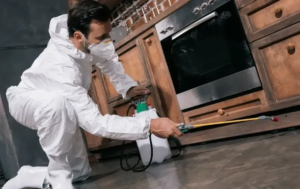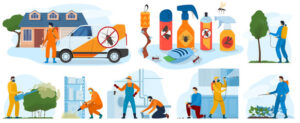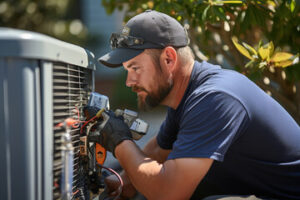Rodents, insects, and other pests can cause damage to crops, food, property, homes, and gardens. They also transmit diseases and annoy people.
Many methods are available for controlling pests. The goals of pest control are to prevent and eliminate pests, reducing the harm they cause. Prevention and suppression are usually the primary goals, although eradication may also be an objective in certain situations. Contact Pest Control Meridian ID now!

When it comes to pest control, the old saying, “An ounce of prevention is worth a pound of cure,” rings true. Pests thrive in areas of high moisture and nutrient availability. Consequently, it is important to keep the environment in and around your home or business as dry as possible. This can be done by removing hydration sources and addressing conditions that are conducive to pest infestations, including food waste, trash, and clutter.
Clutter provides places for pests to breed and hide, while also preventing you from seeing them when they are active. Regular cleanings, vacuuming, and sweeping can remove the crumbs and other debris that attract pests. Additionally, storing food in sealed containers and regularly throwing away trash helps to reduce pest-attracting conditions. In addition, regularly sealing cracks and crevices in the walls can help prevent pest entry.
Keeping an eye out for pest activity and listening for scratching, scurrying, or squeaking noises can also help to thwart an infestation in its early stages. Odors are often another indicator of a pest problem. For example, a musty or ammonia-like smell can indicate the presence of mold and may be caused by a rodent infestation.
The more invasive the pest, the harder and more costly it is to eliminate them from your property. By investing in preventative measures, you can avoid a full-blown infestation and the subsequent property damage, health risks, and stress that come with it.
Chemical pest control solutions can be an effective part of your prevention strategy. These include repellents that deter pests from entering, and insecticides that kill pests once they are within your perimeter. However, these treatments are typically reactive and must be used on an as-needed basis outside of your routine pest service.
While treatment is an important part of any pest control plan, it should be considered a last resort after inspection and prevention methods are exhausted. While treating an existing infestation is important for eradicating pests, it’s much more cost-effective to prevent them in the first place. This is why preventative pest control services are so important.
Pesticides
Pesticides are substances that kill, incapacitate or deter pests, which are organisms that destroy crops, cause disease in livestock or people, or are nuisances. They are typically chemicals, but can also be biological agents such as viruses, bacteria, fungi, or even microbes. Pesticides are categorized by their mode of action, target organism, and toxicity. They can be natural or synthetic, and may be made from organic (carbon-containing) or inorganic materials. They are often grouped into chemical families because they have similar properties or act on the target pests in the same way.
The primary benefit of pesticides is their ability to protect crops from being destroyed by weeds, insects or other species. They are often used in conjunction with other methods of pest control, such as mechanical removal and cultural practices to achieve maximum efficacy.
There are a number of disadvantages to pesticide use, however. They are extremely toxic to humans and other species when consumed or inhaled, and they can cause damage to the environment. Those who use pesticides must follow strict safety precautions to minimize exposure, and there are often associated risks that must be weighed against the benefits of using them. Typical associated risks include skin and eye irritation, respiratory distress, and potential damage to the environment.
Pesticides can also be transferred to other locations through soil or water, and they may persist in the environment for a long time. They can alter the balance of a habitat or disrupt ecosystems, and they are particularly damaging to aquatic systems because they can leach into groundwater or run off into waterways. They can also be harmful to birds, mammals, fish, and beneficial insects, and can have negative effects on honeybees and other pollinators.
Proper pesticide use can decrease the associated risks to a level deemed acceptable by the appropriate regulatory authority. These agencies normally require that the product be labeled with a skull and crossbones symbol, indicating extreme danger, and provide information on how to minimize the risk of exposure. The label should also indicate whether the pesticide is systemic or non-systemic. A systemic pesticide moves into the plant through the xylem or phloem, and will act on the targeted organisms inside. A non-systemic pesticide stays on the surface of the plant and acts by direct contact with the organism.
Traps
Traps are used to monitor pest populations and provide valuable information about the timing of insecticide applications or releases of natural enemies. There are many different trap types and each is designed to target a particular insect species or crop. Most use some form of glue to catch insects, and the best ones take advantage of the behavior of the insect species they are designed to capture. They may also incorporate a food bait or other attractant such as pheromones, odors or sound. Some traps also have a method of eliminating the captured pest, such as a kill strip, water or soapy water.
Some traps, such as the bucket-style trap shown here, use a pheromone lure and a kill strip in a bucket to trap pest insects. These can be used to monitor pests or control them when they are present in the garden, or to make mass captures of large numbers of pest insects. Other types of traps, such as a cone-shaped trap (pictured below), can be used to catch pests that attack fruit trees such as apples or cherries. They may be baited with a specific chemical or made to resemble a particular fruit to lure the pests into the traps.
Many types of pheromone traps are available that are designed to monitor insect population levels and help determine the optimal time for applying pesticides or release of natural enemies. Some can even alert the grower to a possible pest infestation before it becomes apparent through visual inspection.
Other traps, such as the yellow sticky trap shown here, are used to monitor the aphid pest (Thylakomyces eugeniae) that attacks vegetables such as tomatoes, cucumbers and peppers. It works by attracting these insects with the scent of aphid secretions. The aphids then stick to the sticky substance, making it impossible for them to escape or be freed from the trap.
When using traps, the best practice is to check them often so that non-target organisms or beneficial insects do not get caught by accident. Also be sure to place traps on stable ground, as some animals do not like entering boxes that move or rock.
Exclusion
One of the most significant advances in pest control over time has been a shift from blanketing facilities with chemicals to focusing on preventative measures. Pest exclusion services are an important part of this, as they involve finding the holes, cracks and entry points that allow cockroaches, rodents, birds, squirrels and other pests to get into a facility and then sealing them. This is a far better option than trying to eradicate an infestation once it’s taken hold, since it’s much easier and safer for the environment.
A skilled pest control company should offer this service, and it should be part of a year-round pest maintenance plan. It’s important to remember that some areas of a building need to remain breathable and ventilated, so water-permeable materials should be used in weep holes, woven hardware cloth should be utilized for soffit and ridge vents, and wire mesh should be used on garbage shoots. It’s also important to inspect all exterior and interior entry points, so that they can be appropriately sealed.
This type of prevention can be used to keep out roaches, rodents, birds, mice and other pests in hospitals, warehouses, day cares, offices and even homes. It’s not only an environmentally friendly alternative to pesticide use, but it’s far less disruptive to employees, students, patients and clients as well.
Pest exclusion should be done in conjunction with trapping and baiting, as it’s not as effective alone. However, it is a great way to prevent pests from re-entering a building if they have already established themselves in an area. In fact, for some pests (such as mice) it’s necessary to do both. The reason is that if you seal the hole that the mouse uses to enter a home, but then you introduce a new pathway by removing the food source or trapping it, you’ll have a big problem on your hands again. For this reason, most pest professionals will recommend that you do population reduction before doing exclusion, so that the mouse is forced to take the secondary route and not your home.







